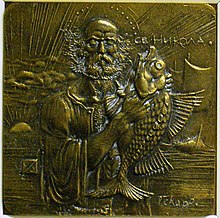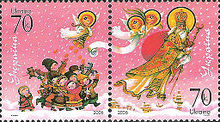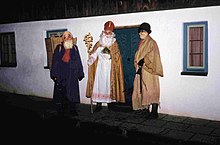Saint Nicholas Day
(Redirected from St Nicholas Day)
Jump to navigation
Jump to search
This article needs additional citations for verification. (December 2018) (Learn how and when to remove this template message)
|
| Saint Nicholas Day | |
|---|---|

A depiction of Saint Nicholas and his companions visiting children
| |
| Official name | Feast of Saint Nicholas |
| Observed by | Anglicanism, Catholicism, Eastern Orthodoxy, Lutheranism, Reformed[1] |
| Type | Christian and |
| Significance | Feast day of Saint Nicholas |
| Celebrations | placing shoes in the foyer before bedtime |
| Observances | Attending mass or [other] service |
| Date | 6 December (Western Christianity); 19 December (Eastern Christianity) |
| Frequency | annual |
The American Santa Claus, as well as the British Father Christmas, derive in part from Saint Nicholas and in part from the Dutch Sinterklaas, the saint's name in that language. However the gift giving associated with these descendant figures is associated with Christmas Day rather than Saint Nicholas Day itself. In England and Scotland St. Nicholas day is celebrated on the 4th of December.[5]
Traditions by continent
Europe
Balkans
A modern metal icon of St. Nicholas by the Bulgarian artist Georgi 'Chapa' Chapkanov. Gilbert House, Stanley, Falkland Islands.
2006 Christmas stamp, Ukraine, showing St. Nicholas and children
In Greece, Saint Nicholas does not carry an especial association with gift-giving, as this tradition is carried over to St. Basil of Caesarea, celebrated on New Year's Day. St. Nicholas being the protector of sailors, he is considered the patron saint of the Greek navy, military and merchant alike, and his day is marked by festivities aboard all ships and boats, at sea and in port. It is also associated with the preceding feasts of St. Barbara (4 December), St. Savvas (5 December), and the following feast of St. Anne (9 December); all these are often collectively called the "Nikolobárbara", and are considered a succession of days that heralds the onset of truly wintry cold weather in the country. Therefore, by tradition, homes should have already been laid with carpets, removed for the warm season, by St. Andrew's Day (30 November), a week ahead of the Nikolobárbara.
In Serbia, and among the Serb people living across the world, Saint Nicholas is the most widely celebrated family patron saint, celebrated as the feast day (Slava) of Nikoljdan. Since Nikoljdan always falls in the fasting period preceding Christmas, it is celebrated according to the Eastern Orthodox fasting rules ("Post"). Fasting refers in this context to the eating of a restricted diet for reasons of religion. This entails the complete avoidance of animal-sourced food products (meat, milk, dairy products and eggs). Fish may be eaten on certain days
In Bulgaria, Saint Nicholas Day is celebrated on the 6 December as Nikulden. Families invite relatives, sponsors and neighbors for a meal of fish (usually ribnik, a carp wrapped in dough) and two loaves of ceremonial bread, all of which are blessed at church or at home. The host wafts incense over the table, then lifts and breaks the bread. Bulgarians also observe 6 December as the name day for those with the names Nikola, Nikolay, Kolyo, Nikolina, Neno, Nenka, Nikoleta and Nina.[9]
Belgium, Netherlands, Luxembourg and Lower Rhineland (Germany)
Sinterklaas in the Netherlands in 2007
In the days leading up to 5 or 6 December (starting when Saint Nicholas has arrived by steamboat around mid-November), young children put their shoes in front of the chimneys and sing Sinterklaas songs. Often they put a carrot or some hay in their shoes, as a gift to St. Nicholas' horse. In recent years the horse has been named Schimmel or Amerigo in the Netherlands and Slecht Weer Vandaag in Flanders. The next morning they find a small present in their shoes, ranging from sweets to marbles or some other small toy. On the evening of 5 December, Sinterklaas impersonators (often parents or close by family) bring presents to children who have behaved well (or not; they often both receive presents) in the past year. In practice, just as with Santa Claus, all children receive gifts without distinction. This is often done by placing a bag filled with presents outside the house or living room, after which a neighbor or parent bangs on the door or window, pretending to be Sinterklaas' assistant. Another option is to hire or ask someone to dress up as Sinterklaas and deliver the presents personally. Sinterklaas wears a bishop's robes including a red cape and mitre and is assisted by many mischievous helpers, called 'Zwarte Pieten' ("Black Petes") or "Père Fouettard" in the French-speaking part of Belgium, with black faces and colourful Moorish dress, dating back two centuries. In the past, it was said that the Zwarte Pieten took all the naughty children, put them into sacks, and Sinterklaas took them with him to Spain (it is believed that Sinterklaas comes from Spain, where he returns after 5 December), in order to scare the children. Therefore, many Sinterklaas songs still allude to a watching Zwarte Piet and a judging Sinterklaas.
Recently, there has been a recurrent discussion about the perceived politically incorrect nature of Zwarte Piet. In particular Dutch citizens with backgrounds from Suriname might feel offended by the Dutch slavery history connected to this emblem and regard the representation of Zwarte Piet as racist. Others state that the black skin color of Zwarte Piet originates in his profession as a chimney sweep, hence the delivery of packages through the chimney.[10]
In recent years, Christmas, along with Santa Claus, has been pushed by shopkeepers as another gift-giving festival, with some success; although, especially for young children, Saint Nicholas Eve is still much more important than Christmas. The rise of Father Christmas (known in Dutch as de Kerstman) is often cited as an example of globalization and Americanisation.[11]
On the Frisian islands (Waddeneilanden), the Sinterklaas feast has developed independently into traditions very different from the one on the mainland.[12]
In Luxembourg, Kleeschen is accompanied by the Houseker a frightening helper wearing a brown monk's habit.
Eastern Europe
In Slovenia Miklavž (Sveti Miklavž) and in Croatia, Nikolaus (Sveti Nikola) who visits on Saint Nicholas day (Nikolinje in Croatia and "Miklavževanje" in Slovenia) brings gifts to children commending them for their good behavior over the past year and exhorting them to continue in the same manner in the year to come. If they fail to do so they will receive a visit from "Parkelj" who traditionally leaves a rod, an instrument their parents will use to discipline them.In the Czech Republic and Slovakia, Mikuláš, in Poland Mikołaj and in Ukraine Svyatyi Mykolay is often also accompanied by an angel (anděl/anjel/anioł/anhel) who acts as a counterweight to the ominous devil or Knecht Ruprecht (čert/czart). Additionally, in Czech Republic, Poland and in Slovakia children find the candy and small gifts under the pillow, in their shoes or behind the window the evening of 5 December or the morning of 6 December.
In Hungary, Croatia and Romania, children typically leave their boots on the windowsill on the evening of 5 December. By next morning Nikolaus (Szent Miklós traditionally but more commonly known as Mikulás in Hungary or Moş Nicolae (Sfântul Nicolae) in Romania) leaves candy and gifts if they have been good, or a rod (Hungarian: virgács, Romanian: nuieluşǎ) if they have been bad (most children end up getting small gifts, but also a small rod). In Hungary he is often accompanied by the Krampusz, the frightening helper who is out to take away the bad ones.
In Slovenia, Saint Nikolaus (Miklavž) is accompanied by an angel and a devil (parkelj) corresponding to the Austrian Krampus.
In Ukraine, St Nicholas (Mykolaj) visits good children during the night (18–19 December [O.S. 5–6 December]) and puts presents under the pillow. For the naughty children Mykolaj brings a rod (Rizka) so parents can use it to discipline them. Usually Mykolaj is accompanied by an Angel (Janhol) and a Devil (Chort).
France
Saint Nicholas originates primarily in Alsace, Nord-Pas-de-Calais (French Flanders), and in Lorraine, where he is patron. A little donkey carries baskets filled with children's gifts, biscuits and sweets. The whole family gets ready for the saint's arrival on 6 December, with grandparents telling stories of the saint. The most popular one (also the subject of a popular French children's song) is of three children who wandered away and got lost. Cold and hungry, a wicked butcher lured them into his shop where he killed them and salted them away in a large tub. Through St. Nicolas' help the boys were revived and returned to their families, earning him a reputation as protector of children. The evil butcher followed St. Nicolas in penance ever since as Père Fouettard. In France, statues and paintings often portray this event, showing the saint with children in a barrel.Bakeries and home kitchens are hives of activity as spiced gingerbread biscuits and mannala (a brioche shaped like the saint) are baked. In schools, children learn songs and poems and create arts and crafts about St. Nicolas, while in nursery schools, a man portraying St. Nicolas gives away chocolates and sometimes little presents. He is sometimes accompanied by an actor playing Père Fouettard, who, like his German counterpart Krampus, carries switches to threaten the children who fear he will advise St. Nicolas to pass them by on his gift-giving rounds.
Central Europe
St. Nicholas and his companions in Haunzenbergersöll, Bavaria (1986)
In Austria, Bavaria and Tyrol (Austro-Bavarian regions), St. Nicholas is accompanied by Krampus, represented as a beast-like creature, generally demonic in appearance. Krampus is thought to punish children during the Yule season who had misbehaved, and to capture particularly naughty children in his sack and carry them away to his lair. The creature has roots in Germanic folklore; however, its influence has spread far beyond German borders, in Austria, southern Bavaria, South Tyrol, northern Friuli, Hungary, Slovenia, the Czech Republic, the Slovak Republic and Croatia. 5 December is Krampus Night or Krampusnacht, in which the hairy devil appears on the streets. Traditionally young men dress up as the Krampus during the first week of December, particularly on the evening of 5 December (the eve of Saint Nicholas day on many church calendars), and roam the streets frightening children with rusty chains and bells. Sometimes accompanying St. Nicholas and sometimes on his own, Krampus visits homes and businesses. The Saint usually appears in the Eastern Rite vestments of a bishop, and he carries a ceremonial staff. Nicholas dispenses gifts, while Krampus supplies coal and the ruten bundles. (Video Krampuslauf Lienz 2010) Krampus is featured on holiday greeting cards called Krampuskarten. There are many names for Krampus, as well as many regional variations in portrayal and celebration. [13]
Krampus parade in Pörtschach am Wörthersee (2013)
Nikolaus-Umzug in Fribourg, Switzerland (2009)
Italy
St. Nicholas (San Nicola) is the patron of the city of Bari, where it is believed he is buried. Its deeply felt celebration is called the Festa di San Nicola, held on the 7–9 of May. In particular on 8 May the relics of the saint are carried on a boat on the sea in front of the city with many boats following (Festa a mare). As Saint Nicholas is said to protect children and virgins, on 6 December there is a ritual called the Rito delle nubili: unmarried women wishing to find a husband can attend to an early-morning Mass, in which they have to turn around a column 7 times. A similar tradition is currently observed in Sassari, where during the day of Saint Nicholas, patron of the city, gifts are given to young women who need help to get married.In the provinces of Trieste, Udine, Belluno, Bari (Terlizzi and Molfetta), South Tyrol, Trentino and in the eastern part of the Province of Treviso, St. Nicholas (San Nicolò) is celebrated with gifts given to children on the morning of 6 December and with a fair called Fiera di San Nicolò[14] during the first weeks of December. Depending on the cultural background, in some families this celebration is more important than Christmas.
Like in Austria, in South Tyrol Saint Nicholas comes with krampuses. Instead, in Val Canale (Udine) Saint Nicholas comes to chase the krampuses: after a parade of krampuses running after people, Saint Nicholas comes on a chariot and give gifts to children (Video "San Nicolò caccia i Krampus a Tarvisio" 6.12.2010)
Malta
In Suhuan, St. Nicholas (mt: San Nikola, less commonly San Niklaw) is the patron saint of the town of Siġġiewi where his feast is celebrated on the last Sunday in June. The parish church, dedicated to the saint, was built between 1676 and 1693. It was designed by the Maltese architect, Lorenzo Gafà, with the portico and naves being added by Nicola Zammit in the latter half of the 19th century. The ruins of a former parish church are still visible and have recently undergone restoration.Portugal
In one city (Guimarães) in Portugal, St. Nicholas (São Nicolau) has been celebrated since the Middle Ages as the patron saint of high-school students, in the so-called Nicolinas, a group of festivities that occur from 29 November to 7 December each year. In the rest of Portugal this is not celebrated.Slavic countries
Celebration of Slavic cakes, grain and wine
Spain
St. Nicholas ("San Nicolás") is the patron of the University of Valladolid, one of the medieval universities of Spain, and Alicante city.[citation needed]Middle East
Lebanon
Saint Nicholas is celebrated by all the Christian communities in Lebanon: Catholic, Greek Orthodox, and Armenian. Many places, churches, convents, and schools are named in honor of Saint Nicholas, such as Escalier Saint-Nicolas des Arts, Saint Nicolas Garden, and Saint Nicolas Greek Orthodox Cathedral.Holy Land
Saint Nicholas Church, Beit Jala
North America
Saint Nicholas Day event held in 1892 by the Saint Nicholas Society
See also
External links
- St. Nicholas Center: Who is Saint Nicholas?
- Biography of St. Nicholas
- The History of Santa Claus and Father Christmas
References
The influence of the Dutch Reformed Church represents the primary Dutch contribution to the culture of the region, along with holiday traditions such as New Year's Day and the St. Nicholas tradition.
- Meg Kissinger, Milwaukee Journal Sentinel 1999, "St. Nick's Day can be a nice little surprise" Archived December 24, 2008, at the Wayback Machine.
Languages
In Myra, the traditional St. Nicholas Feast Day is still celebrated on December 6, which many believe to be the anniversary of St. Nicholas' death. This day is honored throughout Western Christendom and some times in America in Christian families , in lands combrising both Catholic and Protestant communities (in the Eastern Orthodox Church, the Saint's feast date is December 19). On December 5, the eve of St. Nicholas Day, some American boys and girls put their shoes outside their bedroom door and leave a small gift in hopes that St. Nicholas soon will be there.
Down to within recent times in the church of S. Nicola in Carcere at Rome, the generosity of St. Nicholas was annually commemorated, by the giving of gifts to poor children in the sacristy after the memorial Mass on St. Nicholas' day.
|access-date= requires |url= (help)
After having lost their regular mass, Slovaks gathered as a group for religious services only twice a year: on St. Nicholas Day and at the multicultural mass organized by the Archdiocese of Ottawa. To Slovaks, as to other Central Europeans, St. Nicholas was the original "Santa Clause," and it was he who brought presents to the children. In mainstream North America, the St. Nicholas Day celebration (6 December) has somehow been moved to Christmas day (25 December).
Traditionally, in Germany and Poland boys dressed as bishops begged alms for the poor.









